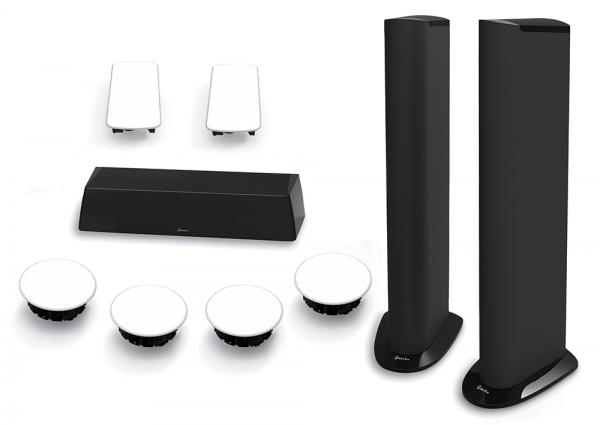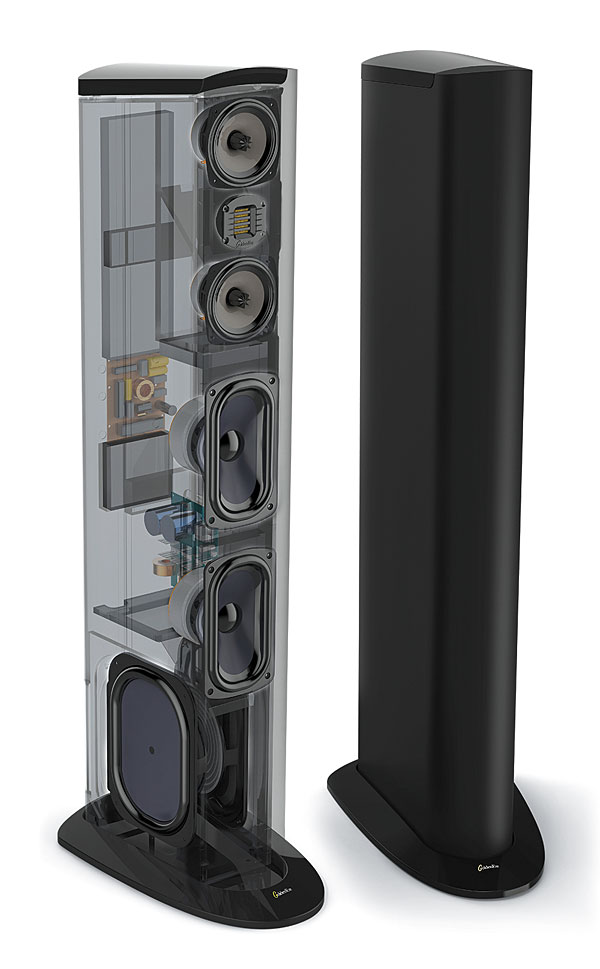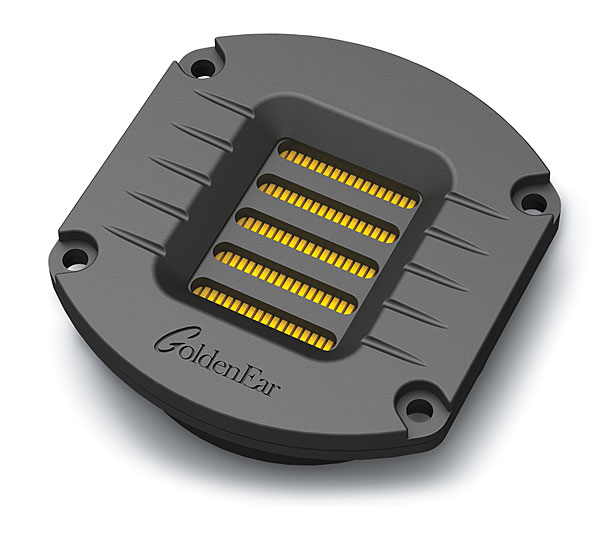GoldenEar Technology Triton Two+ Speaker System Review

AT A GLANCE
Plus
New DSP for low-frequency tuning
Totally redesigned midrange drivers
Balanced crossover with polypropylene capacitors
Minus
Bright blue power LED on back of tower
THE VERDICT
With the hindsight of four years of product development, GoldenEar reboots their very first speaker with updated drivers, crossover, and low-frequency DSP—to quite stellar results.
Unfortunately, the first GoldenEar Technology Triton Two loudspeaker I ever saw didn’t work. It wasn’t the result of shoddy workmanship, chintzy materials, or some brutal, shipping-induced internal hemorrhage of crossovers and cables. Truth be told, the speaker wasn’t technically a Triton Two because, at the time (in early January during CES 2010), GoldenEar Technology didn’t officially exist. The tall, dark tower standing silently in front of me was a cosmetic mock-up of what would become the Triton Two— GoldenEar’s first speaker. In other words, this mute monolith, wrapped in black fabric, was merely a hollow shell of its future towerful self.
I won’t spend much time retelling GoldenEar’s back story. If you’re interested in learning the impressive pedigree, see my review of the Triton One (Sound & Vision, June 2014 and soundandvision.com). The SparkNotes version goes like this, beginning in 1972: Sandy Gross co-founded Polk Audio and then Definitive Technology, the latter in partnership with quiet Canadian engineer extraordinaire Don Givogue. Gross and Givogue emerged from semi-retirement in 2010 (word is that Givogue was “slightly” reluctant and had to be dragged off his fishing boat) to start GoldenEar. This time around, Gross told me then, he wanted to design loudspeakers that sounded like the $10,000-plus pair of electrostatics he had in his listening room at home— but speakers that would be easier to live with and, most important, cost a lot less.

The Optimist’s Primes
After five years, the prime-numbered Triton speaker range includes, in order of creation, the Two, Three, Seven, Five, and ultimately, even though by definition not a prime number though integral to defining a prime number, the One. The Triton One is a truly amazing-sounding loudspeaker. But the fact that a pair of Ones will set you back only $5,000 is stunning. So many glowing reviews of the speaker have been published that I’ve heard the Oxford English Dictionary is planning to define “Triton One” as “so astoundingly awesome, you should bring along an extra pair of underwear.” (Or something like that.) There may also be a Triton One emoji coming soon.
Gross and Givogue don’t sit around all day building prototype speakers in their parents’ garages. GoldenEar has an engineering facility in Arnprior, Ontario, Canada. There, Bob Johnston and a team of engineers have enviable access to the company’s own full-size anechoic chamber, which Gross says is a “duplicate of the world-famous chamber at the NRC [National Research Council of Canada].” GoldenEar’s chamber is so serious that it’s “fully suspended from its environment, so that the delicate measurements taken within it are not interfered with by outside disturbances and vibrations such as beer bottles being opened or hockey pucks hitting the outside.” Actually, the beer and hockey references were added by me, not Gross. The point is that the chamber allows GoldenEar to measure subtleties and refine a speaker’s performance in a manner that’s potentially more revealing than other methods would be.
Although the anechoic chamber isn’t new, Gross says that since initially designing the Triton Two and Three speakers, GoldenEar acquired new development software, “including a unique program for cones and surrounds.” (He means the surrounds that encircle the outer edges of cone drivers—not surround speakers.) In other words, GoldenEar’s golden ears learned quite a bit along the Via Triton that culminated in the One.

That left the original and early Triton Two feeling severely outdated. Gross wanted to produce a reality TV show, called Rehab My Speaker (the working title was Crossover This!), but he couldn’t get HGTV to run it. Instead, after binge-watching several seasons of The Six Million Dollar Man from the 1970s, Gross decided that the GoldenEar team should do their own upgrading of the Triton Two. Wisely realizing that no one would buy a Triton Two+ for six million dollars (GoldenEar speakers may be good, but they ain’t that good), the engineers didn’t add sophisticated robotic legs or computerized telescopic eyes—but the changes they did make were certainly noticeable.
Old Highs with New Lows
From the outside, the Triton Two+ looks virtually identical to the original Triton Two (the non-plus—but definitely not nonplussed—version). It has the same black cloth fabric over a columnar grille in the front, with a gloss black plinth and matching cap. The only difference is that the amplifier power-status LED is now a relatively bright blue, rather than the more subtle green. It’s bright enough that, in a very dark room, you might notice a radioactive-looking blue glow spilling along the floor behind the speaker. If it bugs you or breaks your mood, you can always put a piece of black electrical tape over it.
Behind the grille, the Two+ inherits the same High Velocity Folded Ribbon (HVFR) tweeter found in the Two and all the other Triton speakers. As we’ve frequently pointed out, this is technically a magnetic planar tweeter design that utilizes a flat diaphragm that has been pleated, like the sides of a squeeze-box (or accordion, for highfalutin people), and it creates sound by rapidly squeezing and stretching the pleats to compress and rarefy air. This proprietary tweeter plays a huge role in giving all the GoldenEar speakers their characteristic sound.
Brand new, however, are the two 4.5-inch midrange drivers mounted above and below the HVFR tweeter in a D’Appolito arrangement. They’re a huge beneficiary of Triton One hand-me-down technology, as they were re-engineered with a new cone, surround, spider, and voice coil. GoldenEar also developed a completely new balanced crossover incorporating polypropylene capacitors, one that is very similar to the crossover in the Triton One. The DSP-based low-frequency control unit for the amplified bass section has been reprogrammed, too. Gross was emphatic about getting the crossover design right. In fact, just like the cardinals at the Vatican when electing a new Pope, the engineers were locked in a room and required to try out all sorts of “subtle variations of crossover and DSP tuning in order to get the voicing exactly right.”
As as a result of the upgrades, Gross says the Triton Two+ benefits from “a significantly smoother, higher-resolution, more open, more revealing, and more highly detailed sound. In addition, there is dramatically more expansive imaging and tighter, faster, and better-integrated bass.”
The Big and Tall Man’s Center
We wanted to take the opportunity presented by the arrival of the Triton Two+ to listen to a few other GoldenEar models we’ve not yet heard, so we set up a Dolby Atmos 5.0.4 system that also included the new SuperCenter XXL center-channel speaker along with a pair of Invisa MPX in-walls for surrounds plus two pair of Invisa HTR 7000 in-ceiling speakers for the front and rear height channels. The middle zero in the Atmos configuration numbering isn’t a typo. Not only did GoldenEar not send a dedicated subwoofer, but—as per Gross’s usual recommendation—I also set the front speaker parameter to Large and ran only speaker wires to the Triton Two+ towers. In other words, neither the subwoofer output of the AVR nor LFE input on the Two+ was used. All deep bass was provided by the Tritons with their powered bass sections and built-in crossovers.
The appropriately named SuperCenter XXL is a monster, measuring 35 inches wide x 5.75 inches high x 11 inches deep. Inside the familiar black-fabric-sock grille cloth is a two-and-a-half-way design utilizing a three-chambered cabinet. The central chamber holds one HVFR tweeter plus two 5.25-inch woofers that are coupled to a 7 x 10-inch top-firing passive radiator. Two smaller chambers sandwich the central section, and each contains its own 5.25-inch bass driver (crossed over at a lower frequency than the 5.25-inch drivers used in the middle) coupled to a dedicated 6.75 x 8-inch passive radiator, which is also top-firing.
- Log in or register to post comments





































































